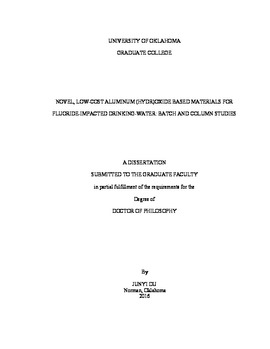Novel, low-cost aluminum (hydr)oxide based materials for fluoride-impacted drinking-water: Batch and column studies
Abstract
Simple aluminum (hydr)oxides and layered double hydroxides were synthesized using common chemicals and equipment by varying synthesis temperature, concentrations of extra sulfate and citrate, and metal oxide amendments. Aluminum (hydr)oxide samples were aged at either 25 or 200 oC during synthesis and, in some cases, calcined at 600 oC. Despite yielding increased crystallinity and mineral phase changes, higher temperatures had a generally negative effect on fluoride adsorption. Addition of extra sulfate during synthesis of aluminum (hydr)oxides led to significantly higher fluoride adsorption capacity compared to aluminum (hydr)oxides prepared with extra citrate or no extra ligands. X-ray diffraction results suggest that extra sulfate led to the formation of both pseudoboehmite (γ-AlOOH) and basaluminite (Al4SO4(OH)10·4H2O) at 200 oC; energy dispersive X-ray spectroscopy confirmed the presence of sulfur in this solid. Treatment of aluminum (hydr)oxides with magnesium, manganese, and iron oxides did not significantly impact fluoride adsorption. While layered double hydroxides exhibited high maximum fluoride adsorption capacities compared to aluminum (hydr)oxides, their adsorption capacities at dissolved fluoride concentrations close to the World Health Organization drinking water guideline of 1.5 mg/L were much lower than those for the aluminum (hydr)oxides.
Molecular sieves and zeolites showed increased fluoride adsorption capacities when amended with aluminum (hydr)oxide (AlOOH). When normalized by the AlOOH content, the adsorption capacities of most amended molecular sieves were higher than the maximum theoretical value expected for monolayer surface coverage, suggesting fluoride removal from processes beyond adsorption, such as precipitation. Although the mass-normalized adsorption capacities of most amended materials were less than that of an equivalent mass of pure AlOOH, several molecular sieves with pores of one to several nanometers showed mass-normalized adsorption capacities similar to pure AlOOH, possibly due to their larger pores, which may have facilitated fluoride adsorption after aluminum (hydr)oxide precipitation. Energy dispersive X-ray spectroscopy detected elevated fluorine in a representative AlOOH-amended molecular sieve after repeated fluoride adsorption, also consistent with fluoride uptake by processes beyond only monolayer coverage. Regeneration of the adsorbents with low-concentration sodium hydroxide solution led to partial recovery of the fluoride adsorption capacity, which decreased over the course of sequential adsorption batch experiments, possibly due to loss of aluminum.
Pure aluminum (hydr)oxide (AlOOH) and AlOOH-amended sodalite (prepared with 0.6 M aluminum chloride, 0.18-0.425 mm sodalite, and at pH 5.3) exhibited good performance in column fluoride removal in terms of service time (time until breakthrough), energy consumption, and cost. The long service time (1370 and 2000 bed volumes for AlOOH-amended sodalite and pure AlOOH, respectively) was primarily due to a large mass loading of AlOOH in amended materials when using small-size substrate zeolite and high aluminum concentration, and secondarily to the amorphous state of AlOOH formed at a slightly acidic pH (5.3). Column effluent water showed signs of aluminum leaching for the first 70 bed volumes due to the outflow of AlOOH particles. Once AlOOH particles smaller than 0.2 μm stopped exiting the column, the effluent aluminum concentration stayed below 0.2 mg/L, from 70 bed volumes to breakthrough. However, aluminum concentrations increased after breakthrough; this was attributed to fluoride-induced AlOOH dissolution and formation of aqueous aluminum-fluoride complex. There was no significant reduction of fluoride removal capacity from competing solutes (bicarbonate, silicate, sulfate, and pyromellitic acid) present at five times higher concentration than the fluoride content. The estimated energy requirement of 2.13×10-4 and 0.011 kWh/m3 treated water for household and community-scale filters is much lower than the energy consumption of electrocoagulation (10.8 kWh/m3) and reverse osmosis (5 kWh/m3), and is favorable for the practical use of these materials. In the absence of continuous power supply, hydrostatic energy can be used to run the community-scale filter using an elevated water tank about four meters above the ground. The cost advantage ($0.97 and $1.05 per cubic meters of treated water for producing pure AlOOH and amended sodalite) makes these materials appealing to developing regions compared to the production cost of activated alumina ($2.94/m3 treated water). The cost can be further decreased by using aluminum sulfate during amendment or reusing adsorbents after one cycle of regeneration with 0.01 M sodium hydroxide.
Collections
- OU - Dissertations [9477]
